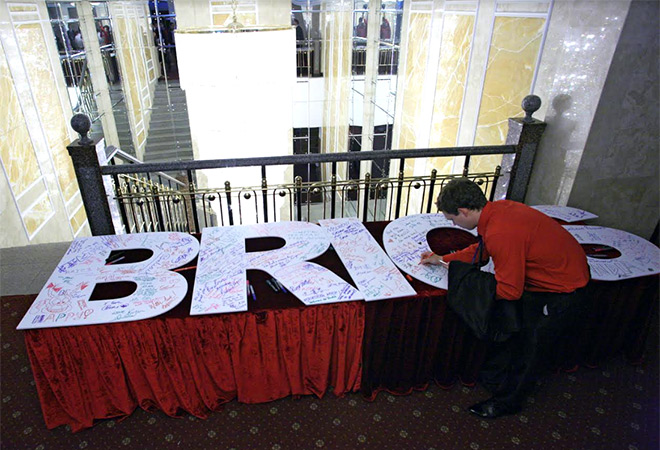-
CENTRES
Progammes & Centres
Location

Image Source: Ria Novosti/Getty Images
The standstill agreement reached between the United States and China on 1 December 2018 on the sidelines of the G-20 meetings has brought the much-needed breather for these two countries and the rest of the world. Both the countries agreed not to impose any tariffs for the next 90 days. However, this temporary truce does very little to resolve the deeper trade problems in their relationship and seems to be a more short-term political agreement than a substantive step towards the resolution of the existing problems.
The temporary nature of the agreement has been immediately highlighted when on 4 December 2018 US President Donald Trump tweeted: “I am a Tariff Man. When people or countries come in to raid the great wealth of our Nation, I want them to pay for the privilege of doing so… We are right now taking in billions (of dollars) in Tariffs. MAKE AMERICA REACH AGAIN.”
Without going into the wrong economics behind it, the intent shown clearly demonstrates the uneasiness of the truce between these two.
Though not much highlighted in the news, in another significant development, India, in its second attempt, secured the World Trade Organization’s (WTO) approval to establish a dispute settlement panel to provide ruling on the unilateral duties imposed by the US on the imports of steel and aluminium. India’s first request was blocked by the US on 21 November. But when a complainant makes a second request, the panel usually gets automatically established. Switzerland joined India in making the second request against American import duties.
Therefore, existing confrontations on the tariff front are very much going on – involving major players of international trade.
The US, meanwhile, has single-handedly blocked a proposal for filling four vacancies of the WTO’s Appellate Body (AB) as the country feels that in the past, the body went beyond its mandate in its rulings. This is another part of the broad American narrative that “the system is rigged against us”. AB is a standing body of seven persons that hears appeals from reports/rulings issued by dispute settlement panels at the WTO. The AB reports, once adopted by the Dispute Settlement Body, must be accepted by all the parties involved under the existing rules and procedures governing the settlement of disputes at the WTO.
Due to the US blocking for the past two years, the AB is now reduced to three members from seven. And by December 2019, the AB will get reduced to a single member body when two more members – one from India and the other from the US – retire at the end of their second terms.
India joined the European Union, China, Canada, Norway, New Zealand, Switzerland, Australia, Korea, Iceland, Singapore and Mexico to issue a joint proposal to fill up the vacancies on 26 November. However, using its veto power, the US once again rejected the proposal on 12 December, and called the EU, India and China the “new trilateral” (at WTO), which is trying to “change the rules to authorise and accommodate the very approaches that would make the Appellate Body even less accountable”.
This persistent blocking of filling vacancies of the Appellate Body seems to be an American ploy to go back to the pre-1995 GATT (General Agreement on Tariffs and Trade) phase where the rulings of any dispute settlement panel can be negotiated as opposed to the AB’s mandatory implementation under the current two-stage dispute settlement system. If that happens, then it will be a telling blow to the credibility of the WTO.
So, trade battles are been fought in different multilateral spheres other than tariff front, and there are enough reasons to be sceptical about the US-China standstill agreement on tariffs.
“Reinvigorating Trade and Inclusive Growth” – a policy paper charting out directions for future international trade reform, published by the World Bank (WB)-International Monetary Fund (IMF)-WTO trio in September 2018 – should be read in the context of these changing winds of international trade. A closer reading of this proposal paper reveals worrying trends for emerging economies like India in near future.
The paper surprisingly does not criticise the unilateral tariff impositions of recent times even once, and instead mentions (only once) in the beginning – “The system of global trade rules that has nurtured unprecedented economic growth across multiple generations face tensions. Though only recently brought to the fore, these tensions are rooted in issues that have been left unresolved for too long. Governments need to promptly address outstanding questions involving, for example, the WTO dispute system and the reach of subsidy disciplines”.
This is nothing but a backhand justification given for the American stance of imposing unilateral tariffs.
The WTO secretariat technically cannot be party to such a biased reform proposal of international trade as it does not have any decision-making power. In WTO, all decisions are taken by the member countries only, and the secretariat’s duties are “to support various councils and committees, to provide technical assistance, to monitor and analyse developments in world trade, to provide information to public and media, and to organise the ministerial conferences”. Ministerial conference is the highest decision-making body in the WTO under the existing framework.
The policy paper further goes on to say that “… reliance on an approach in which all members must agree on all issues risks driving negotiating activity outside the WTO. Agreeing among so many members, each with unique challenges and priorities, has proven difficult”. Since inception, a consensus-based multilateralism has been the bedrock of the WTO and is the primary reason behind its immense success in promoting free trade in the past. Not so subtly, this WB-IMF-WTO proposal is challenging that consensus-based approach of trade negotiations here.
The paper then makes an argument to employ a ‘plurilateral’ and ‘flexible’ approach in negotiations within the WTO on any issue where consensus does not emerge as “the practice of bundling negotiating issues together in a giant, all-or-nothing trade rounds has become extremely difficult to manage”. This is like proposing separate clubs within the WTO, and essentially treating some groups of countries as superior to other groups of countries. It is an absurd idea to sustain in a multilateral forum where all countries are supposed to be treated at par with each other. It is like saying that any country is free to negotiate its own kind of bilateral or plurilateral deals under the WTO umbrella. But, why would countries do that under the WTO when they have the option of doing it outside independently? It looks like a desperate attempt of the WTO to remain relevant in international trade.
In contrast to these arguments, the policy paper then advocates for a universal approach to investment to set “holistic rules critical in a world of regional and global value chains”. It also reiterates the necessity to resolve thorny issues like market access in agriculture, distortions in agricultural trade, regulatory cooperation, and e-commerce. While acknowledging the variability of interests on these issues, the paper prescribes ‘evolution’ and ‘modernisation’ of rules, policies and practices governing global trade.
If one reads between the lines, then it implies that accommodating different obligations of emerging economies and less developed countries in implementing tariff schedules and service commitments may come under scanner under this ‘flexible’ approach of trade negotiations in future.
On questions like market access, possibility of future arm-twisting cannot be ruled out either. Countries like India, Brazil and China will get affected adversely in future if this proposed approach is accepted further at the WTO level.
This is not good news for the emerging economies, for example the BRICS countries. These countries negotiated hard for deferment of tariff schedules and services commitments in the past to protect their own economic and development interests. Under this proposed “plurilateral flexible” approach those benefits may just disappear.
Going by this trade reform proposal advocated by the WB-IMF-WTO trio, the cost of unilateral tariff imposition, as started by the US, finally would have to be borne by the countries of the world which are growing the fastest – the BRICS countries and the Next Eleven. It is unlikely that multilateral organisations like the WTO will have the requisite instruments to stop unilateral and arbitrary trade decision making of the US. Economic and political might of the US, on the contrary, is likely to bend these institutions in its favour.
After the 2008 financial crisis, international platforms like G-7 and G-20 crystallised their cooperation in regulating financial markets across the world to provide stability to the international monetary systems.
In contrast, formations like the BRICS evolved through a larger cooperation in international trade negotiations. In other words, trade blocs or formations based on south-south cooperation have larger stakes in the multilateral rules-based WTO. Unfortunately, the WTO does not seem to be a ‘saviour’ of these countries this time.
As pointed out by British entrepreneur Martin Sorrell, “The fast growing markets – the BRICS and Next Eleven – are the key. The next billion consumers are not going to come from the US or Western Europe – they are coming from Asia, Latin America and Africa”. So, all international future games of trade wars will also be revolving around capture of this emerging consumer base.
Now, when multilateralism is in dire straits and immediate future is not looking so good, these countries (BRICS and Next Eleven) urgently need preparation and planning to face more protectionism in international trade. Only larger cooperation among themselves can protect their interests in the new world trade order, which may decisively tilt towards the advanced countries – particularly the USA – in the short run.
(This article is based on a short presentation made by the author at the international seminar “BRICS Economic Agenda: Searching for New Ways of Cooperation and Development” on 4-5 December 2018. It was organised by the Institute for Applied Economic Research (IPEA), Brazil.)
Next Eleven countries are Bangladesh, Egypt, Indonesia, Iran, Mexico, Nigeria, Pakistan, Philippines, South Korea, Turkey and Vietnam.
The views expressed above belong to the author(s). ORF research and analyses now available on Telegram! Click here to access our curated content — blogs, longforms and interviews.

Abhijit was Senior Fellow with ORFs Economy and Growth Programme. His main areas of research include macroeconomics and public policy with core research areas in ...
Read More +